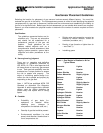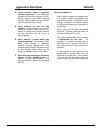
Application Data Sheet ADS-001
Sierra Monitor Corporation 1991 Tarob Court Milpitas, California 95035 (408) 262-6611 (800) 727-4377 fax: (408) 262-9042
C. Place sensors close to possible
sources of gas leaks. This includes gas
cylinders, any device using gas, valves,
fittings, flanges, pump seals, pressure
vessels, tubing jungles and gas infusion
from the ground or other routes.
D. Place sensors for use as area
monitors. Area monitors are used as
backup to sensors located close to the
source of a leak and to monitor sources
that are not fixed such as cars in a
parking garage.
E. Place sensors in areas where gas
might accumulate. These areas include
above false ceilings, in stairwells,
gratings, storage cabinets and other
locations where gases might migrate due
to their density and/or might not be
subject to ventilation typical of the area.
F. Place toxic gas and oxygen deficiency
sensors in the “breathing zone” in
addition to areas defined above. The
breathing zone is typically 4-6 feet above
the floor.
Other Considerations
After location is determined based upon
A-F above, consider accessibility and
maintenance issues. Sometimes a minor
change in location of a sensor module
will enhance access with no detriment to
functionality.
Some gases can be both combustible
and toxic. Typically, the toxic levels are
much lover than the LEL levels.
The proper concentration to be monitored
is determined by the user. For
example, in a usually unmanned area, a
user may want to monitor for the gas at
LEL levels because of the concern of an
explosion.
In some cases, the true gas risk is the
displacement of oxygen rather than the
presence of the toxic gas. In such cases,
it is best to install an oxygen deficiency
sensor module to protect the personnel.




